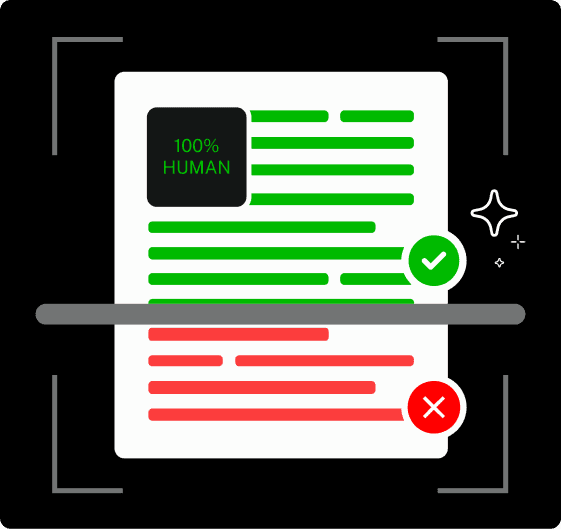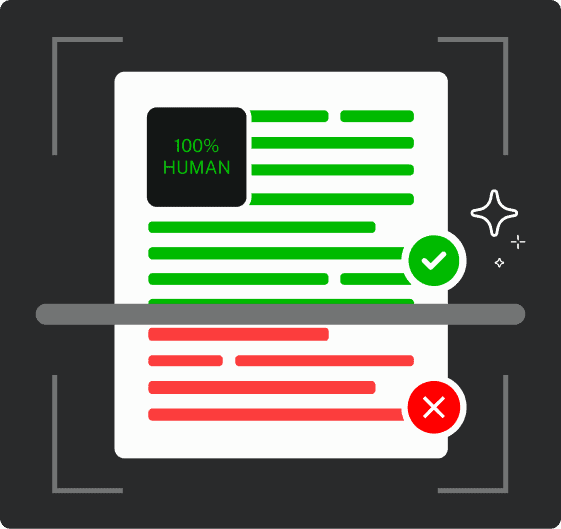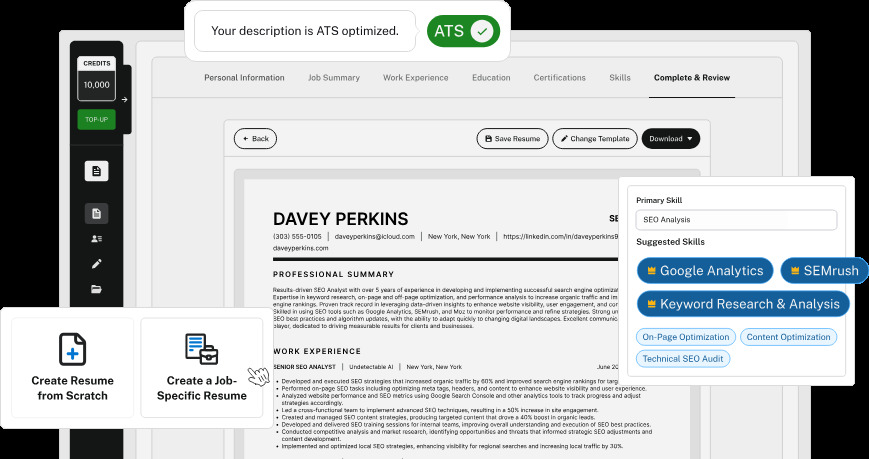If you’re job hunting, you’ve probably heard the word resume thrown around a million times.
But what exactly is it? More importantly, how do you make yours stand out in a sea of job applications?
Most people treat it like a boring checklist of jobs and degrees. That’s a huge mistake.
Your resume is a sales pitch. It tells employers, This is why you need me on your team.
A weak resume blends into the pile, while a strong one opens your doors before you even say a word.
In this guide, I’ll break down what is a resume really, the best formats to use, real-world examples, and how to make yours impossible to ignore.
What Is a Resume?
At its core, a resume is a marketing document that tells a story, your story.
It highlights what you’ve done, what you’re great at, and how you can add value to the company.
A resume is not an autobiography.


Never Worry About AI Detecting Your Texts Again. Undetectable AI Can Help You:
- Make your AI assisted writing appear human-like.
- Bypass all major AI detection tools with just one click.
- Use AI safely and confidently in school and work.
It doesn’t list every single job you’ve ever had or every skill you’ve ever learned.
Instead, it’s a curated selection of the most relevant and impactful aspects of your career that align with a specific job posting.
Why Every Job Seeker Needs a Resume?
A lot of people think, “Do I really need a resume? Can’t I just apply with my LinkedIn profile?”
No. You still need a resume, even in 2025.
Here’s what is a resume supposed to do:
- Your resume is often your first (and sometimes only) shot at grabbing an employer’s attention. A strong resume opens doors; a weak one closes them before you even get a chance.
- It highlights your accomplishments in a way that makes hiring managers think, “We need this person on our team.”
- It puts you in control of your narrative so you frame your experience the way you want it to be seen.
- It gets you through applicant tracking systems. If you don’t have a resume tailored with the right keywords and formatting, you won’t even make it past the first filter.
In short, without a resume, you’re invisible to employers.
The Difference Between a Resume and a CV
People often use resume and CV (curriculum vitae) interchangeably.
Let’s clear up the confusion once and for all, a resume and a CV are NOT the same thing.
Here’s what is a CV vs resume:
- A resume is your one-to-two-page snapshot made to quickly sell your skills and experience to a hiring manager. It’s customized for the specific job you’re applying for and highlights only the most relevant achievements.
- A Curriculum Vitae (CV) is a multi-page document that covers your entire academic and professional history. It includes publications, research, presentations, awards, teaching experience, and more. CVs are mostly used in academia, research, and medicine, where a detailed record of your career is required.
What is a cover letter for a resume?
If you’re applying for a corporate job, you generally need a resume, and sometimes CV (only when specifically asked).
Types of Resume Formats (Which One Should You Use?)
By now, you know that a good resume is your ticket to better job opportunities.
The way you structure your resume matters just as much as what you put in it.
DIfferent resume formats highlight your career trajectory in different ways. Which one should you use? Let’s break it down.

1. Chronological Resume (Most Common Format)
The chronological resume is the most widely used format.
It lists your work experience in reverse chronological order such that your most recent job appears first, followed by previous roles.
It’s best suited for those with a stable career history and clear progression because it shows how you’ve grown over time.
If you’ve held consistent jobs without significant gaps and if your most recent positions are highly relevant to the job you’re applying for, this is the format you should use.
However, if you have frequent job changes or employment gaps, a chronological resume will do more harm than good.
2. Functional Resume
A functional resume flips the traditional structure on its head by focusing less on job titles and dates and more on skills and accomplishments.
Instead of listing jobs in order, you group your experience under specific skill categories, such as “Project Management,” or “Sales & Client Relations.”
The functional resume is particularly useful for career changers or freelancers because it puts skills front and center rather than work history.
However, many corporate recruiters don’t like this format because it lacks a clear work timeline, and it’s only natural for them to know where and when you developed your skills.
3. Combination Resume (Best of Both Worlds)
The combination (or hybrid) resume is exactly what it sounds like.
It blends elements of both chronological and functional resumes by listing key skills and achievements at the top, followed by a reverse-chronological work history section.
It’s an excellent format if you have both strong skills and a solid work history but want to shift the focus to your expertise rather than just job titles.
This format is also more flexible. You can highlight your strongest skills upfront while still providing a clear employment timeline.
How to Make a Resume That Stands Out
Most resumes fail for one simple reason: they blend in.
Hiring managers see the same lifeless phrases over and over, “hardworking team player,” “detail-oriented professional,” “seeking a challenging position.”
If your resume sounds like everyone else’s, why would they choose you?
You need a resume that gets noticed and here’s how to build one.
Step 1: Choose the Right Format
Before you even start typing, you need to pick a format that works for your career situation, chronological, functional, or combination (read the previous heading again for explanations on formats).
You can also use Undetectable AI’s Resume Builder to instantly generate the best resume format for your experience and career goals.

Just input your details and it will automatically generate the format that works for your career trajectory.
Step 2: Write a Strong Resume Summary or Objective
Your resume summary/objective is a quick snapshot of your qualifications and the first thing a recruiter will read.
The resume summary is best for experienced professionals.
It highlights key achievements and experiences in a concise 2-3 sentence statement, for example,
“Marketing specialist with 5+ years of experience in SEO, content strategy, and digital campaigns that boosted engagement by 40%.”
The objective is for entry-level candidates or career changers that defines the skills and career goals rather than past experience, such as
“2023 Computer Science graduate with strong Python and JavaScript skills passionate about developing AI-based, user-friendly software solutions.”
Whatever you do, don’t waste this section with fluff like, “Seeking an opportunity to utilize my skills in a dynamic work environment.” That says nothing about you.
Step 3: Highlight Your Work Experience Effectively
Here, you add a quick description of the impact you made at your previous workplaces.
If all you do is list job titles and responsibilities, you’re wasting prime resume real estate.
Employers don’t care about what you were supposed to do. They care about what you actually accomplished at the place you worked.
Pro Tip: Use the STAR method when describing your work experience:
- Situation: What was the challenge?
- Task: What was your responsibility?
- Action: What did you do?
- Result: What was the measurable outcome?
Step 4: Showcase Your Skills
Your skills section should be tailored to the job you’re applying for.
A generic list of skills will not be effective, each skill you mention must be relevant to the position and backed by evidence in your experience section.
For example, if you’re applying to a software engineering position, you could highlight your technical skills like:
- Python, Java, C++
- Full-Stack Development
- Machine Learning
- Agile Methodologies
Step 5: Keep Your Resume ATS-Friendly
Most companies use Applicant Tracking Systems (ATS) to filter resumes before they reach a human recruiter.
If your resume is not formatted correctly or lacks the right keywords, it will never be seen.
To ensure your resume passes ATS filters:
- Use standard resume section headings like “Work Experience” and “Skills” instead of creative alternatives.
- Incorporate keywords from the job description. If the posting emphasizes “social media strategy,” and your resume only mentions “online marketing,” even though you mean the same, you will be filtered out.
- Avoid graphics, tables, and unusual fonts that are unlikely to be read by ATS software.
Step 6: Keep It Concise & Error-Free
Recruiters spend an average of six seconds to scan a resume before deciding whether to continue reading.
A cluttered resume with vague language or errors will not hold their attention for long.
Avoid overloading it with overused resume buzzwords and keep it concise.
A resume should be one page for early-career professionals and no more than two pages for experienced candidates.
Before submitting your resume, use Undetectable AI Humanizer to refine your wording and ensure clarity because the last thing you want is for a recruiter to suspect AI-generated fluff.
Test the AI Humanizer and the AI Detector in the widget below!
Resume Examples for Different Careers
An entry-level resume won’t look the same as a senior-level one because hiring managers at different levels expect different things.
Here are some resume examples for individuals at different stages of the career ladder.
Entry-Level Resume Example
John Doe
📍 New York, NY | ✉ johndoe@email.com | 📞 (123) 456-7890 | 🔗 LinkedIn.com/in/johndoe
Professional Summary:
Recent marketing graduate with hands-on experience in social media strategy, content creation, and data analysis.
Adept at creating engaging content, analyzing trends, and driving audience growth and seeking to bring creative problem-solving and analytical skills to [Company Name].
Key Skills
- Social Media Management (Instagram, LinkedIn, TikTok)
- Content Creation & Copywriting
- Google Analytics & SEO Basics
- Data Analysis & A/B Testing
- Email Marketing & CRM Tools
Education:
Bachelor of Science in Marketing | University of XYZ | 2024
Relevant Experience:
Marketing Intern | XYZ Agency | Summer 2023
- Managed social media accounts and grew engagement by 40% in three months through targeted content.
- Assisted in executing a paid ad campaign which added to a 15% increase in website traffic.
Freelance Social Media Manager | 2022–2023
- Increased a local brand’s Instagram following by 2,500+ in four months through organic engagement strategies.
Certifications & Additional Training:
- Google Analytics Certification | Google, 2023
- HubSpot Content Marketing Certification, 2023
2. Mid-Level Resume Example (Advancing in Career, More Responsibilities)
Jane Smith
📍 Los Angeles, CA | ✉ janesmith@email.com | 📞 (987) 654-3210 | 🔗 LinkedIn.com/in/janesmith
Professional Summary:
Results-driven project manager with 5+ years of experience leading cross-functional teams in tech environments. Proven ability to streamline workflows, optimize project delivery, and enhance efficiency by up to 30%. Passionate about delivering projects on time and within budget while fostering collaboration and innovation.
Key Skills:
- Agile & Scrum Methodologies
- Process Optimization & Workflow Automation
- Cross-Functional Team Leadership
- Budget & Resource Allocation
- Risk Assessment & Problem-Solving
- Jira, Asana, Trello
Work Experience:
Project Manager | ABC Tech | 2020–Present
- Led 8+ cross-functional teams in delivering software projects and reduced turnaround time by 25% through process optimization.
- Implemented Agile methodologies that cut project delays by 40% and increased team productivity.
- Managed a project portfolio worth $2M where all initiatives met KPIs and business objectives.
Project Coordinator | DEF Software | 2018–2020
- Assisted in managing SaaS product development and delivered three major feature launches ahead of schedule.
- Created dashboards in Jira and Asana to improve team efficiency
Certifications & Training:
- Certified Scrum Master (CSM) | 2021
- PMP Certification | Project Management Institute, 2022
Senior-Level Resume Example (Executive or Leadership Role)
Michael Johnson
📍 San Francisco, CA | ✉ michaeljohnson@email.com | 📞 (555) 123-4567 | 🔗 LinkedIn.com/in/michaeljohnson
Executive Summary:
Award-winning Chief Marketing Officer (CMO) with 15+ years of experience driving revenue growth, brand positioning, and multi-channel marketing strategies. Proven track record of scaling brands, optimizing marketing ROI, and leading high-performing teams.
Core Competencies:
- Strategic Planning & Growth Marketing
- Brand Positioning & Market Expansion
- Digital Transformation & E-Commerce Growth
- Data Analytics
- Executive Leadership
- P&L Management & Budgeting
Professional Experience:
Chief Marketing Officer (CMO) | Global Tech Inc. | 2018–Present
- Spearheaded a digital transformation strategy that resulted in a 50% increase in online revenue within two years.
- Led a 50+ member global marketing team, implementing AI-driven consumer insights to refine customer targeting.
- Overhauled content strategy and performance marketing and reduced customer acquisition costs by 30%.
Vice President of Marketing | XYZ Corporation | 2014–2018
- Developed an integrated marketing plan that increased brand recognition by 60% in competitive markets.
- Implemented a new data-driven approach to campaign optimization that led to a 35% boost in conversion rates.
- Managed a $20M+ marketing budget while maximum ROI across all channels.
Education
Master of Business Administration (MBA), Marketing & Strategy | Stanford University | 2012
Bachelor of Science in Business Administration | University of California, Berkeley | 2008
Board Memberships & Industry Recognition
- Forbes “Top 50 CMO Leaders” 2023
- Keynote Speaker at Global Marketing Summit 2022
- Panelist at CES 2021—”Data-Driven Decision Making in Branding”
- Advisory Board Member – AI in Marketing Consortium, 2019–Present
How to Apply for Jobs Efficiently After Creating Your Resume
Creating a polished resume is where the game actually starts.
The difference between casually sending out applications and landing interviews comes down to strategy and efficiency.
Recruiters can spot generic applications from a mile away.
Always take a few minutes to tweak your resume and cover letter to include keywords from the job description.
If you’re applying to jobs manually, you’re already behind because when you don’t apply quickly, someone else does.
Take advantage of Undetectable AI Smart Applier to automatically submit tailored applications to the best-fit jobs so you’re constantly in the running.

Final Thoughts!
I hope this article made you learn what is a resume and what it is supposed to do.
Though, I get that the entire job hunting process is exhausting.
Writing tailored resumes in the right format and clear structure and applying to dozens of jobs is a full-time job on its own.
Fortunately, there are now tools you can use to automate your job search without compromising quality or missing out on opportunities.
Undetectable AI has a set of tools that not only helps you create a high-impact and professional resume in minutes but also applies to jobs for you.
Try Undetectable AI’s Resume Builder today.
